les Nouvelles October 2020 Article of the Month:
People As Enablers:
The Role Of The Human Factor In Intellectual Asset Management Of Technology
 Thomas Bereuter
Thomas Bereuter
Innovation Support Programme Area Manager, European Patent Academy, European Patent Office
Munich, Germany
 Adéla Dvořáková
Adéla Dvořáková
Legal Officer, European Commission - Research Executive Agency
Brussels, Belgium
 Juergen Graner
Juergen Graner
Founder and CEO, Globalator
San Diego, United States
 Bowman Heiden
Bowman Heiden
Co-Director, Center for Intellectual Property (CIP), University of Gothenburg
Gothenburg, Sweden
 Ruud Peters
Ruud Peters
IP business leader, Peters IP consultancy, former Chief Intellectual Property Officer (CIPO) of Philips
Valkenswaard, Netherlands
Abstract
The potential value of technology and intellectual property (IP) assets can be fully realized only if it is accompanied by a people-centric perspective. For an efficient intellectual asset management of technology, a number of key players inside and outside an organization must be considered, as well as cultural factors. To achieve ultimate success, the views and roles of business decision-makers and IP managers must support and complement each other in an integrated, IP-driven environment throughout all phases of the intellectual asset (IA) value chain.
In phase 1, when IAs are created, the focus is on the work done by IP managers, while decision-makers provide the frameworks for success. The three key recommendations during this phase are to employ a pro-active IA management approach that supports creativity, practice open innovation by allowing external influences on the process, and create a working environment to attract and keep talent.
In phase 2, when the technology created is assessed and protected, IP managers play a leading role, while decision-makers provide oversight and guidance, with the common goal of having a product or service that can be monetized in the final phase. The three key recommendations during this phase are to integrate key business functions to ensure alignment, implement milestone-based management that allows for repeated stop-or-go decisions for expenditure/opportunity optimization, and create an incentive system with the aim of achieving alignment through success-related incentives.
In the last phase, phase 3, business decision-makers take the lead to realize the value created during the previous phases by selling related products and services or strategic transactions (alliances, licensing, spin-offs, acquisitions and divestments), while IP managers move into a support role. The three key recommendations in this phase, with its focus on high value-generating strategic transactions, are to ensure management continuity throughout all stages of a strategic transaction, plan ahead to be strategy-driven rather than opportunity-driven, and align through success-related payments with transaction partners to optimize financial returns.
All phases of IA management require a high level of knowledge of IP on the part of everyone involved. The three key recommendations to enhance IP know-how are to provide appropriate training for executives and R&D personnel, become part of the IP/business community through attending conferences and other events, and learn from best practices by means of training events and publications.
1. Introduction
Value realization through business transactions is the ultimate goal of decision-makers in technology companies. This article is based on the understanding that to untap the potential value of technology, attention must be focused on the people that work with research and development (R&D) and intellectual property (IP) and their ability to manage technology and IP from a strategic business perspective to create value. Thus, innovation capacity should be measured not only by the quantity of R&D investment and number of patents, but also by the quality of these activities measured in terms of business impact. It is important to understand that the value of both technology and IP assets fundamentally depends on the quality of the people involved in their creation, management and commercialization. For a company, neither technology nor IP has a value in and of itself (see Figure 1).
This article focuses on intellectual assets (IA) and intellectual asset management capabilities from a technology perspective. Intellectual assets in the technological context include both technology assets (e.g., inventions, know-how, software, designs, etc.) and intellectual property assets (i.e., patents, copyrights, industrial design rights and trade secrets), which are the most important legal tools for protecting and controlling technology assets.1 Intellectual asset management includes the organizational processes and human capital to create, manage, and commercialize technology and IP assets. Figure 1 provides an overview of the relationship between technology/IP assets and technology/IP management capabilities, the latter being the specific focus of this article.
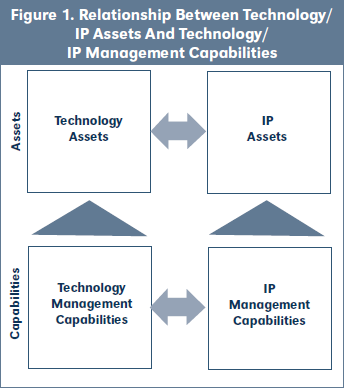
2. Status of Intellectual Asset Management of Technology
2.1 Technology and Intellectual Property Assets
This article builds on the observation that the potential value of technology/IP assets can only be fully realized if it is accompanied by a people-centric approach. For that purpose, the concept of technology and IP assets comprises not only technical knowledge and IP rights but also the people that created them (see Figure 2).2
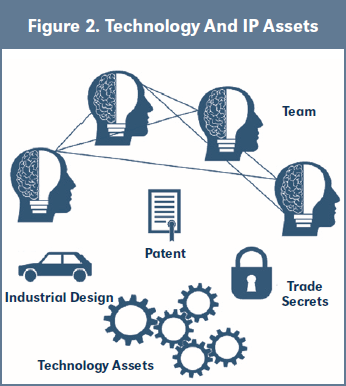
The importance of recognizing and identifying know-how as a separate asset to be distinguished from other technology assets3 is based on the fact that its considerable share is tacit,4 i.e., not possible to imitate or transmit, and thus held by people rather than the company.5 Empirical research shows that individual human capital relates positively to firm (innovation) performance.6 In addition, and the reason why the team and not just the individual's know-how should be recognized, the literature suggests that while knowledge is held at the individual level, its value can only be fully utilized when it is shared.7 Thus, it is the team-specific knowledge that makes the biggest contribution to a company's competitive advantage.8
2.2 Perspectives on the Intellectual Asset Value Chain
In business practice, views on IA management may differ depending on whether it is seen from the decision-maker or IP manager perspective.
The common decision-maker view tends to focus on the achievement of business objectives, with the main goal being to capture value from technology assets by way of business transactions (ranging from simple transactions where a product is sold all the way to strategic transactions, like alliances, licensing, spin-offs, acquisitions and divestments). The creation and management of IA based on a proper business-driven IP strategy is merely a necessary prerequisite for achieving that ultimate goal.
The traditional IP manager view is based on the classic four pillars of IP management: creation in the sense of development of the technology, assessment of its potential, decision on protection and, to a lesser extent, value creation as the enabler but not the driver.9 IP managers tend to focus more on the phases that precede the ultimate value creation and place great emphasis on the details of IP strategy implementation, starting with the efficient creation of an IP portfolio, as well as the assessment and protection of technology assets.
Figure 3 depicts the main phases of the IA management value chain from the perspectives of decision-makers and IP managers, highlighting the phases where they focus most of their efforts.10 The different parts of that value chain do not necessarily happen in a linear pattern. In many cases this is an iterative process, where managers jump back and forth between the different phases along their pathway to value generation.

Phase 1: Creation
In the creation of technology, the decision-maker's main role is to give direction by defining the business case and deriving a supportive IP strategy. Depending on the size and maturity of the company, top management is typically not involved in detailed operational activities of IA.
IP managers traditionally work on the details of this phase by providing tools, processes, guidance, support and feedback to the R&D teams. This includes awareness-raising activities and training, establishing practical invention disclosure procedures, supporting patent searches and making appropriate recommendations as to which technologies and inventions to focus on as a result of broader assessments.
Phase 2: Management & Assessment and Protection
Throughout the entire process of building a proper IA portfolio, the decision-maker's role is to focus on giving direction to the team, managing external collaborations and providing resources. Generally speaking, decision-makers regard the building of an IA portfolio as an integrative IA management task that secures proper alignment throughout the company and supports the availability of the required external know-how. Ultimately, when it comes to decisions on patenting or other forms of IP protection, decision-makers rely on the IP management team (which can be internal or external).
IP managers on the other hand focus their attention on assessing technologies and the corresponding invention disclosures, making decisions on protection and searching for synergies among the teams. They identify inventions and concentrate their efforts on creating an appropriate IP portfolio while keeping expenditure to a minimum.
Phase 3: Transactions & Value Creation
Once a created technology is properly protected against the competition by a meaningful IP portfolio, the focus switches to value realization, which is the focal point for decision-makers. This is the phase when the company receives a return on its investment. In order to realize value for a company, some kind of transaction needs to take place. From a business decision-maker perspective, business transactions make the value measurable in financial terms, and this value ends up in the financial statements. From a shareholder perspective this might be the payment of dividends or the sale of equity.
The conventional transaction form to derive value from technology is the sale of related products and services. However, strategic transactions, like alliances, licensing, spin-offs, acquisitions and divestments, have the potential for high value generation on a different time axis than product or service sales agreements, with the added benefit of internal operational risk reduction. For intellectual assets in particular, the value realization through strategic transactions can be substantial.11 For the purpose of this article the focal point of section 3.3 related to the transaction phase is on strategic transactions.
IP managers usually refer to the last phase of IA management as the value creation phase (see Figure 3), although value is created all along the way. While IP managers have a more pro-active role during the preceding phases, during the value creation phase they fulfill more of a support function. Their importance for strategic transactions must not be underestimated though. They often "prepare the ground" for transaction success by providing expertise for negotiations and due diligence12 processes as required.
2.3 Key Players in the Intellectual Asset Management of Technology
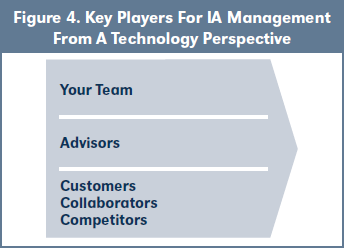
In each of the phases of the IA value chain described, different key players are involved, both internally as well as externally.
Innovation starts with ideas from individuals, and these individuals are part of a team. The core team, therefore, plays a vital role, as it possesses the knowledge necessary to create innovation output and in doing so, to create value. The recurring pattern in most companies is that innovation output is unequally distributed among individual inventors in such a way that the main number of patents is attributable to just a small fraction of talented individuals.13 In addition, research suggests that such prolific individuals have a positive influence on the performance of their collaborators.14 For a technology company, it is therefore important to recognize the importance of prolific inventors to the creation of value for the organization.
Depending on the type of company and maturity of its IP management, the use of external advisors is absolutely key, in the assessment and protection phase in particular. IP is a very complex subject that needs a lot of specialized expertise that may not be available within a company. Advisors also have the advantage that they can input their experience from working with various companies on similar issues—a networking benefit every client can receive. The involvement of advisors, including lawyers, consultants and IP professionals, is also important in strategic transactions. However, external advisors will typically not have the in-depth knowledge of the business and its competitive environment. Therefore, the final decision has to be made internally, and is only supported by the external advice. There is no alternative to establish the required in-house know-how and experience for growth-oriented technology companies.
The relevance of the other external stakeholders is often forgotten. Customers are important for shaping a business and its IP strategy. Collecting feedback from the market helps to discover market needs that a company may be able to satisfy with their inventions (market pull versus technology push).15 To complete the picture of the principles of open innovation, collaborators and business intelligence about competitors need to be considered in a thorough technology management process.
2.4 Cultural Factors for Intellectual Asset Management of Technology
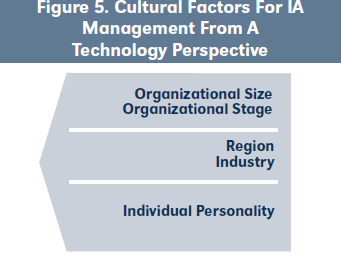
Cultural factors are an additional important aspect that must be considered for the efficient management of intellectual assets. There is no "one-size-fits-all" approach. The organizational size and stage of a company are fundamental, as strategy and management differ depending on whether it is a three-person operation, a global corporation with 10,000 employees, a start-up or a company that has been around for 10 years.
When it comes to finding the right collaborators and assessing competitors, the specifics of the target region and target industry need to be taken into account. It makes a difference if a company is located in China, Germany or the United States. The region influences how an entity operates and functions. Also, the industry sector in which the business operates may have a significant influence. The business environment in the information and communication technology (ICT) area is very different from that in other areas such as pharma or the paper industry. Different product life cycles, product development costs, margins and the like require different IP strategies and IA management practices. What could be true in one industry could be wrong in another. In addition, a company's approach to IA management may differ also within regions and industries, depending not only on its size and organizational stage, but also on its position in the market. The strategy is typically different based on whether the company is positioned as a market leader, follower, challenger or pioneer.
Last but not least, the individual personalities of the people involved play a crucial role. When dealing with collaborators or competitors, the personality, background and experience of the other side's decision-makers and IP managers is just as important as those within your own organization. The personality factor of individuals, especially decision-makers and other team members, does have an impact on the shaping of a company's business and IP strategy. Research suggests, for example, that founder CEOs may show a higher propensity to risk-taking when it comes to decisions on patenting16 or that their hands-on experience in the technology field in which the company operates may lead to increased patent filing and higher-quality innovation produced by the company.17 The CEO's personality may at the same time influence the selection, motivation and performance of the core innovation team.18
In relation to inventors, practice shows, for instance, that they differ in respect of their views on technology and the market and in their "business spirit."19 Such individual characteristics may influence their tendency to prefer some projects over others and influence their motivation in terms of collaboration and engagement.
Thus, the key people are important in the context of the overall culture and business environment, and in creating a comprehensive management strategy for intellectual assets that may lead to high value realization.
3. Key Recommendations for Intellectual Asset Management of Technology
In the words of Mark Zuckerberg: "There are different ways to do innovation. You can plant a lot of seeds, not be committed to any particular one of them, and just see what grows."…"We go mission-first, then focus on the pieces we need and go deep on them and be committed to them."20
A fundamental prerequisite in any approach is the alignment of the IP strategy with the business strategy21 and consequently aligning the operational IP management activities with the overall vision and direction taken. For that, it is crucial that the views and roles of decision-makers and IP managers support and complement each other to achieve success in an integrated, business-driven IP environment.
3.1 Phase 1: Creation
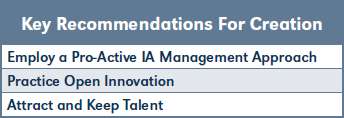
A. Employ a Pro-active IA Management Approach
In the IA creation phase, management focus should be on creating an enabling environment that encourages individual and team performance, thereby enhancing creativity. This can be achieved by employing a pro-active approach aimed at supporting innovation activities and making sure they are going in the right direction.
When it comes to IA creation, R&D staff and inventors must be directed towards the fulfilment of the business's strategic objectives. This should be done by motivating and enabling them to deliver the right solutions. Therefore, strategic thinkers need to be involved to make sure that people are engaged, and resources invested in R&D efforts are constantly readjusted to focus on those projects that potentially create the highest value.
IP managers are responsible for creating awareness among R&D staff to ensure that they understand the strategic focus as well as for regularly reminding them about it. When creating IP awareness, inventors need to be made aware of the importance of capturing value from IP and how that contributes to the performance of the business. These practices can significantly increase the number of inventors that contribute to the IP portfolio. In addition, R&D staff need to be given support in the form of appropriate training, tools and processes, as this will contribute to activating the individual potential that will advance the innovation output of the company as a whole.
One way that IP managers can enhance innovativeness is to regularly examine R&D outputs with the aim of identifying new opportunities for their use. It is often the case that an invention is created as a side-product of another one, or that a potentially valuable discovery is overlooked. In-house technology sourcing is a way of identifying such cases and assessing whether they could be useful for the company's own use or out-licensed to other entities.22 Responsibility for detecting undisclosed inventions lies with both IP managers and R&D departments. It should be made clear to inventors that their duty is to submit information about the existence of any such potentially valuable inventions to their IP professionals. IP managers' crucial role then is to create an enabling environment by raising awareness among the R&D departments, putting in place tools and processes to encourage inventors to do so, and providing guidance on how to proceed in each case. In addition, as a safeguard against avoiding missed opportunities, IP professionals involved must proactively seek any undiscovered inventions in the pool of R&D results. Attention should also be paid to tools created within the company (such as software or other instruments developed with the primary goal of using them in-house), as companies often overlook the value they could potentially create if they were brought to the market.
B. Practice Open Innovation
Companies should also consider engaging external collaborators as a means of increasing efficiency in IP creation. Collaborative R&D with other SMEs or research organizations as part of an open innovation approach can contribute to innovativeness by creating synergies to speed up time to market. In-licensing and out-licensing can be used to diversify the portfolio instead of focusing on internal R&D capacities only. It is in a company's interest to develop a whole "toolbox" where different technology sources complement each other.
To obtain the best possible results from external collaborations and to maximize efficiency, the expectations of all involved must be clearly communicated and their motivations aligned (see Figure 6). Only by doing this can companies mitigate the risk of failure due to misalignment of the individual objectives of the actors involved.
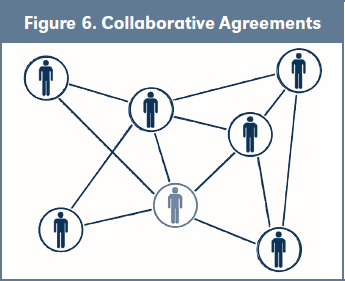
The challenge that many SMEs face when engaging with collaborators is to establish the contractual basis for cooperation. Exact terms must be agreed upon before the start to avoid future disputes regarding the rights to inventions. However, especially for smaller companies with limited experience and resources, this may represent a significant barrier to entering into collaboration agreements. Companies facing these difficulties can make use of a range of recommendations and guidelines, such as the WIPO review about free model contracts.23
C. Attract and Keep Talent
To build a solid basis for innovation activity, decision-makers and IP managers should work together on attracting talented individuals that are able to deliver results. Jointly they can create an environment that motivates prolific inventors to stay and further advance within the company. The individual personalities and motivations of the core innovation team members should be taken into account by managers and decision-makers alike, as commercial success typically requires a certain degree of overlap between the business objective and the inventor's own creativity and perception of success. As a consequence, R&D resources should be directed preferably to inventor teams and individuals, ensuring that their motivation is in line with the business strategy and thus have the highest potential to contribute to value creation (bottom-up approach). In addition, incentives should be designed to support aligning inventor motivation with business and IP strategy (top-down approach).
The role of motivation is two-fold. Sound motivation not only makes people stay with a company, thus preventing the loss of valuable know-how. It also contributes to innovative performance.24 A common way of enhancing motivation is through financial rewards. When designing a system of incentives, attention should be paid to the kind of metrics used, as it could backfire if done in an unbalanced way. Generally speaking, it is regarded as positive to reward inventors (and in many legal systems it is a requirement to do so). It is not enough, however, for a reward system merely to be perceived as fair. Incentive systems that do not reward individual effort appropriately or do not take into account the value of the invention may not have the desired effect.25 Furthermore, metrics need to put quality before quantity in order to meet business needs (simply rewarding the number of patents filed is not enough).
|
A common situation in teams is that performance and motivation are hindered by a small number of individuals. Experience shows that there is a high statistical probability that in teams there will be 10 percent who are not fit for the job,26 and whose repositioning would be beneficial for overall team performance. These individuals should be spotted as early as possible to understand the challenges of the team and whether they can be resolved.27 Some companies, especially larger ones, employ dedicated strategies to ensure that only delivering individuals are on board. Forced ranking is a rather controversial workforce planning approach, but some companies apply an interesting alternative under which employees are regularly offered the possibility to receive a lump sum payment to walk out the door.28 In this way, unhappy employees are spotted more easily and encouraged to leave before they can transmit their frustration to other team members.
|
Financial incentives for inventors need to go hand in hand with other kinds of enticements that focus on the intrinsic motivations of individuals and on enhancing cooperation within and between teams in order to contribute to knowledge diversity.29 Inventors are typically not motivated by monetary rewards alone; other factors contribute to their performance, including recognition of their achievements, a "deserved" high level of autonomy and intellectual challenge.30 Such motivational factors are often more important than the financial incentives. Therefore, initiatives elaborating more on reward and recognition, such as inventor days, innovation awards, dinner with the CEO or other forms of recognition of the achievements of inventors by senior management can help enhance intrinsic motivation.
|
Empowerment is a critical factor in motivation, summing up several factors mentioned, and is therefore a contributor to the performance of a company.31 As Steve Jobs said: "It does not make sense to hire smart people to tell them what to do."32 Once talent is attracted, management should focus on how to leverage their skills to convert their competencies into value for the company. This can be done through establishing a creative and collaborative environment, promoting initiative and engagement through a higher level of autonomy, delegating part of the decision-making authority to the people in charge and enhancing communication between upper- and lower-level management. An interesting example of fostering creativity by affording a larger degree of autonomy is the "20 Percent Project" policy made popular by Google, which allows employees to spend 20 percent of their time on projects and initiatives they think would most benefit the company.33 This inclusive approach, when offered as an option to high achievers, might contribute to an even higher level of motivation, allow them to develop their full potential and create new opportunities for innovation. However, measures like this may not be sensible or feasible in a small company setting.
|
3.2 Phase 2: Management Assessment and Protection
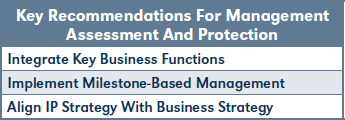
A. Integrate Key Business Functions
In most companies, the R&D, business and IP legal departments are separated from each other without proper alignment. IP management duties are often the responsibility of the in-house legal department, largely working in separation from the other departments, thereby creating silos (see Figure 7). In smaller entities, external IP lawyers often take on that role. Due to cost optimization by small businesses, they are usually not well connected to the whole strategy of the business, which leads to a similar situation of misalignment. In general, lawyers are by definition more focused on managing risks than managing value creation.
Semi-aligned companies have integrated the R&D department with business and IP, but the IP department is still not properly integrated with the business unit.
In contrast, technology-driven companies close that last gap, bringing together all relevant actors from the business, marketing, technical, R&D and IP departments. This top-down integrative approach with intentional overlapping responsibilities is important for achieving unambiguous business goals (see Figure 7) as it secures an internal organization that supports informed decision-making in each phase of the IA management process. Therefore, for efficient IA management, all key business functions need to be integrated in order to get all the information required to make good decisions under the leadership of decision-makers. This integration has to happen not only within the company's internal team, but also with the advisors and collaborators who play an important role during this phase (see also section 2.3). Since this is about teamwork within an organization and outside, cultural factors are crucial, especially if collaborators are located in different geographic regions.
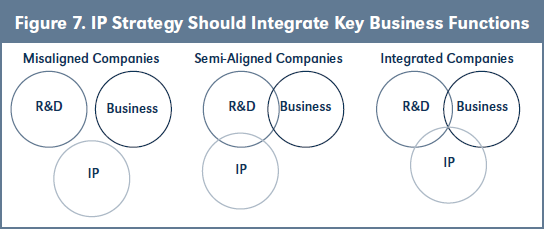
B. Implement Milestone-based Management
Managers should keep in mind that it is a long way from creating technology to getting IP protection and finally realizing value. However, the milestones—priority filing, lapse of the priority year, lapse of 30/31-month period for internationalization, and so on—are generally quite clearly defined by the patent system. These milestones must be recognized and the invention thoroughly assessed at each transition point to ensure that funds are invested in the right projects and the expected return on investment is materialized. Decision-makers34 overseeing the available financial resources must insist on these assessments, although the actual work is usually carried out by IP managers. A typical assessment usually consists of about 40 questions in five main areas: (i) technology, (ii) legal, (iii) market, (iv) finance and (v) strategic fit.35 When a product is developed, experience shows that the same set of questions must be asked about 15-20 times on average in an iterative process until the products or services are put on the market or a strategic transaction is entered into.36
Since the questions relate to different fields (see Figure 8), the relevant information is typically held by different individuals and departments. To make sure that the questions are properly answered, IP managers should adopt a cooperative approach in order to involve the relevant actors in all five areas, brief them upfront, and collect their input before each assessment. This will also increase their commitment and buy-in to the outcomes of the assessment. IP managers should also document and keep a record of past assessments, adding new relevant information at each milestone. In addition, the information should be structured in a standardized way and stored in a shared system that allows other IP professionals to access it anytime. This practice ensures that with every repetition of the assessment potential, stop-or-go decisions will be based on more complete and reliable information and will contribute to informed decision-making on further investments in the technology, the scope of the legal protection and ultimately the selection of relevant markets and partners.
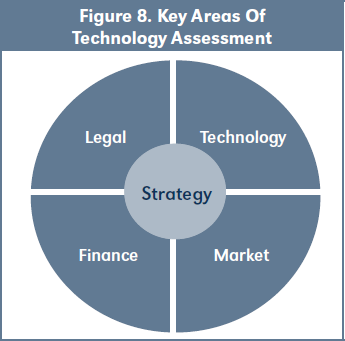
When selecting the countries where IP protection is to be sought, consideration is typically given to the characteristics of the market (especially its size), location of main competitors, options for enforcement in the different countries and, recently to a lesser extent, location of production facilities. As a rule of thumb, companies aim to select the 20 percent of the countries that cover 80 percent of the market (applying the 80/20 rule, commonly used in business resource allocation decisions).
It is also recommended to put in place practices that allow management to learn from past experiences and establish a system with continuous improvement. This has already been recognized and applied in many businesses as the backbone of any Total Quality Management initiative. For example, when assessing invention disclosures prior to filing, the inventor should receive feedback to enable them to understand the reasons why their invention was rejected/accepted for IP protection and further commercialization. One useful practice is to document all assessments at the different stages and flect on whether the decision to proceed with the invention was the right one. This could be expanded to a long-term feedback loop aimed at revision of the IP portfolio and comparing it against the actual value created. Such practices also allow companies to spot the advancement options for future assessments and continuously improve internal decision-making to learn from both successes and failures.
When seeking protection for technology, companies should also consider using IP bundles that allow them to protect different aspects of their products or services by different, complementary IP forms over and above patents. These may include trade secrets, designs and copyrights in particular. Even in patent-intensive industries, trade secrets are often an effective way to protect process innovations in cases where infringement detection or patent enforcement might be a challenge, for example.37 As a consequence, IP managers are also responsible for putting in place internal processes to ensure that every effort is made to keep trade secrets secret, and that all requirements to successfully take legal action against misappropriation of their trade secrets are met.
C. Align IP Strategy with Business Strategy
Where there are no adequate selection processes, IP protection and overall IP management can become costly. Managers should therefore avoid seeing IP as an expensive form of insurance and instead invest in technologies and IP protection within the framework of an IP strategy that supports business strategy in a clearly defined way. While in many companies the IP portfolio is created first and then the decision-makers start to think about how to actually make use of it, the proactive approach would be the exact opposite: define the business strategy first and then align the IP strategy accordingly, with the clearly defined purpose of creating technologies and seeking IP protection. In formulating the business strategy, input from the IP managers about the IP position of their company in relative comparison to their competitors is essential, as well as other relevant IP-related information.
Both business and IP strategies must be clearly communicated to all involved in their implementation to make sure that everyone is heading in the same direction. To achieve that, the IP strategy must be translated into operational plans with clearly defined targets for everyone involved in the process. The plans should be agreed upon with the relevant business units, and acknowledged and deployed throughout the business, R&D and IP departments. If orchestrated in this way, each team will understand where to focus their efforts and how to avoid spending time on technologies and IP that are ultimately not put forward. In addition, by analogy to what has been said about inventors in section 3.1, individual incentives must be based on the same aim: only those efforts that are in line with IP strategy and corresponding operational plans should be rewarded.
3.3 Phase 3: Strategic Transactions and Value Creation
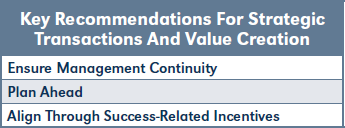
A. Ensure Management Continuity
Decision-makers must ensure management continuity throughout all the phases of a strategic transaction (see Figure 9). The development phase includes the creation and management phase from an IA management perspective (see Figure 3), and the transaction phase of IA management is split here into the actual transaction phase and the implementation phase.

IA do not just appear; they need to be developed by a dedicated team. This initial development phase generally provides the highest value for a transaction. It takes years of dedicated work by the R&D team together with IP managers to provide the foundation for a successful strategic transaction. Since from a transaction perspective the development phase includes the creation, assessment and protection phases (see Figure 3), the internal team and IP managers are the main drivers of value generation, often in collaboration with other entities such as co-development or in-licensing partners. Ideally, customers and competitors should always be considered when developing IA for strategic transactions in order to gain a sound understanding of the market.
When a strategic transaction enters the actual transaction phase, contracts are negotiated. Depending on the type of transaction, the number of parties involved and potential options, this can be a lengthy process. An alliance for example with one potential party might be able to be negotiated in a matter of weeks. On the other hand, the divestment of an entire company (also known as an "exit") with several parties targeted and extensive due diligence periods might take many months. During the transaction phase, it is vital to engage internal and/ or external advisors, especially IP professionals, lawyers and specialist advisors. Depending on the type of transaction, these might include, for example, business development consultants for alliance transactions, licensing specialists for licensing transactions, strategy consultants for spin-off transactions, and M&A (mergers and acquisitions) advisors for acquisitions and divestments. In this phase the foundation is laid to realize value later on. However, if contracts are poorly structured because they do not consider implementation hurdles, value already created is at risk.
Once the contracts have been signed, strategic transactions enter the final implementation phase, where both parties need to "live the deal." Most alliances, licensing deals, spin-offs, acquisitions and even divestments have the potential to create significant value during this phase, provided the implementation is prepared and managed well. The internal teams of both transaction parties play a key role here, as they will need to figure out a way to implement what was negotiated during the transaction phase. Engaging specialist advisors can provide a lot of value as well. Specialist advisors are similar to those engaged in the transaction phase (see previous paragraph); for acquisitions and divestments, however, M&A advisors are replaced by integration consultants.
As described above, there are many players from both inside and outside a company that are involved in the different phases of a strategic transaction. In many cases, their role is limited in time and ends with the termination of the phase concerned. For that reason, decision-makers need to make sure that there is management continuity throughout all phases, and that the ball is not dropped during the transition from one phase to the next. Ideally, companies should create a dedicated position within their organization that is in charge of growth with strategic transactions directly working under and with the CEO. This can be achieved through a dedicated business development position or an active board member. The main responsibility of this transaction driver is to keep a constant strategic oversight of each phase from development all the way to implementation.
B. Plan Ahead
Most strategic transactions underdeliver in business practice. One problem is that there is often no continuous strategic management throughout all phases (see 3.3.A.). Another issue is that transactions are often opportunity-driven and not based on solid strategic planning. Opportunities should not drive a business, but decision-makers should drive opportunities. Businesses should only enter into strategic transactions that support their core strategy. The business strategy may be adjusted, but only after a thorough evaluation of the mid- to long-term effects.
Although it is the right foundation, having a strategy and executing it accordingly is only one factor when it comes to transactions. Companies often fail to plan ahead of a strategic transaction. Planning should ideally be part of the development phase, and definitely part of the transaction phase. What is essential is a thorough understanding of the other transaction party. As mentioned in 3.3.A above, the implementation phase is a high value generator for most strategic transactions. However, it is also the phase where things are most likely to go wrong. During the implementation phase, where two different organizations need to interact with each other, cultural factors (see section 2.4) play an important role. Both sides will have to learn how to deal with the "other side." Finally, for most transactions, at the end of the day, there will be a number of individual personalities on each side that, without any previous experience of each other, will now have to work together.
Only solid planning by team members on both sides before the deal is signed will prevent likely implementation problems. Advisors often get in the way of this since they are mostly focused on the task for which they were hired: the completion of the transaction phase. They are generally not hired to ensure success after the deal has been signed—it simply is not their job. Therefore, the strategic oversight needs to be under the control of the decision-makers, who should always have the whole picture in mind.
C. Align Through Success-Related Incentives
Generally speaking, if executed correctly, success-related incentives can align both parties to a strategic transaction, allowing value to be realized during the important implementation phase. Negotiators should therefore be very careful about deal terms. A so-called "great deal" where the "other side" loses might actually turn into a loss for the "winning party." For example, a licensing deal that provides the licensor with an unusually high percentage of royalty payments might result in the licensee not being economically motivated to employ sufficient resources, since it would not create a sound payback for them. On the other hand, owners do not want to provide IA at deal terms that do not give them sufficient financial incentive to develop the next generation of products. Striking the right balance is actually not necessarily a negotiation but a partnering task and requires a thorough understanding of the business environment.
In addition, during deal negotiations in the transaction phase, advisors need to be made aware of cultural factors on the side of the transaction partner. Lawyers, for example, are often not informed about business decision factors as they relate to the implementation of a transaction, because the focus is on keeping legal costs down. However, aligning your advisors with your business is time and money spent wisely. They can only help if they are filled in on the whole business picture.
4. Support for Businesses
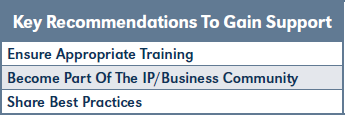
During all phases of IA management, the level of IP knowledge of everyone involved is a crucial success factor. Not only the IP department, but all actors involved in the creation, management and commercialization of the technology must have a corresponding understanding of IP. The same is true for the transaction partners. All involved should "speak the same language," and this can only be achieved by appropriate training. There are many possibilities to enhance the skills of executives and R&D staff of SMEs as well as large enterprises. The European Patent Academy offers classroom and online training on IP strategy and IP management, including value creation/commercialization. The focus is on supporting partners acting as intermediaries, such as the national patent offices, the Licensing Executives Society and the IP Helpdesk, in the form of train-the-trainer activities, including the provision of training material free of charge.38
IP conferences are also an effective way of improving IP knowledge and skills, keeping track of the competitive environment, identifying business opportunities and finding business partners for collaborative research or IP commercialization. Data from a recent study by the European Patent Office (EPO) show that one of the challenges that SMEs face when commercializing their technology is the difficulty of finding the right business partner. Results indicate that, of the inventions held by SMEs in the study that have not been exploited to date, about 19 percent have not been exploited for lack of skills or contacts. Finding the right partner was identified by them as the biggest challenge for collaborative exploitation.39 Attending conferences on intellectual property AND related business aspects offers a great opportunity for IP managers and decision-makers to become part of the community of IP business professionals.40
Sharing best practices is especially important for small companies and start-ups that might not have the necessary experience or resources to be able to rely on professional advice only. The EPO also provides support and guidance to SMEs in the form of training and publications on disseminating best practices and recommendations for IP management.41
5. Conclusion
In order to maximize the value of a company's intellectual assets, the perspectives of decision-makers and IP managers must be aligned along an IA-driven business strategy. The decision-makers' strategic focus can provide guidance to IP managers, who in return provide support through their expertise and day-to-day IP management.
At the core of IA management are people who have the know-how and skills to make success happen. As shown in Figure 10, it is crucial that all relevant key players be involved in the process, starting with the core innovation team, and including advisors and, where appropriate, external players such as partners, customers and competitors. A company's value-creation strategy should take account of cultural factors: the size of the company, its current organizational stage, its location, the industry it is part of and the individual personalities of all involved.
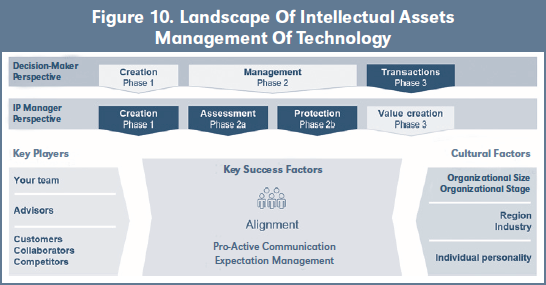
The main success factors in IA management of technology can be summarized as follows:
Alignment throughout the company is a key enabler of success. The business strategy should always be the starting point that shapes the IP strategy. IP input into the process of formulating the business strategy is crucial. All of the key people the company has on board, whether they are internal or external, should share the same vision and pursue objectives that lead to the fulfilment of the business case through the realization of the IA strategy.
Larger companies in particular may find it harder to achieve full alignment due to specialization and lack of cooperation between departments. Organizational structure should therefore integrate all key business functions in an efficient, IA-driven environment. In addition, IP managers should actively seek information from all relevant players to ensure informed decision-making. Pro-active communication within companies, with advisors and with potential strategic transaction partners should be encouraged. Regular exchanges within and between departments should be promoted, reminding all involved of the business case and where the company is heading.
The perception of success of each of the key players should be in line with the perception of success of the company. For that, continuous expectation management taking account of the individual personality of all the stakeholders involved is key. This means, above all, that after engaging talented individuals and establishing win-win relationships with collaborators, managers should focus on setting the incentives in such a way that they allow the overlap between their individual motivations and the company's strategic goals to be enhanced.
IA are one of the main drivers of value within a company.42 But what decision-makers and IP managers should always keep in mind is that the key enablers of success with IA are the people involved. ■
Available at Social Science Research Network (SSRN): https://ssrn.com/abstract=3582079.
Disclaimer: Any opinions expressed in this article are those of the authors and not necessarily those of their respective organizations.
Reference List: The list is in alphabetical order.
Bereuter, Thomas; Yu Sarn Chiew, Juergen Graner & Ilja Rudyk. 2020. "The Making of the High-growth Technology Business Conference 2019: Re-engineering Conference Delivery to Maximize Impact." les Nouvelles 55, no. 2 (June): p. 169.
Birdi, Kamal; Chris Clegg, Malcolm Patterson, Andrew Robinson, Chris B. Stride, Toby D. Wall & Stephen J. Wood. 2008. "The Impact of Human Resource and Operational Management Practices on Company Productivity: A Longitudinal Study." Personnel Psychology 61, no. 3: 467-501.
Blomkvist, Katarina; Philip Kappen & Ivo Zander. 2014. "Superstar Inventors—Towards a People-Centric Perspective on the Geography of Technological Renewal in the Multinational Corporation." Research Policy 43, no. 4: 669-682.
Capretto, Lisa. 2017. "One Of The Biggest Mistakes A Manager Can Make, According To LinkedIn's CEO." HuffPost. Accessed 16.03.2020. bit. ly/huffpost-one-of-the-biggest-mistakes.
Craig, Randall M. 2008. Personal Balance Sheet: A Practical Career Planning Guide. Toronto: Knowledge to Action Press.
EU Observatory on Infringement of IP Rights. 2017. "Protecting Innovation Through Trade Secrets and Patents: Determination for European Union Firms." Accessed 16.03.2020. euipo.europa.eu/ohimportal/en/web/ observatory/observatory-publications.
European IPR Helpdesk. 2015. "Fact Sheet. IP Due Diligence: Assessing Value and Risks of Intangibles." Accessed 16.03.2020. iprhelpdesk.eu/Fact-Sheet-IP-Due-Diligence.
European Patent Office. 2016. "IP Teaching Kit: IP Management." Accessed 16.03.2020. epo.org/teaching-kit.
European Patent Office. Bereuter, Thomas; Yann Ménière & Ilja Rudyk (eds.), 2017. "Unlocking untapped value, EPO SME case studies on IP strategy and IP management." Accessed 16.03.2020. epo.org/sme.
European Patent Office. 2019. "Market success for inventions. Patent commercialization scoreboard: European SMEs." Accessed 16.03.2020.
epo.org/scoreboard-smesl.
European Patent Office. n.d. "European Patent Academy." Last updated 02.11.2017. Accessed 16.03.2020. epo.org/academy.
European Patent Office. n.d. "IPscore." Last updated 18.07.2018. Accessed 16.03.2020. epo.org/ipscore.
Gambardella, Alfonso; Dietmar Harhoff & Bart Verspagen. 2005. "The Value of Patents." Accessed 16.03.2020. zinc.zew.de/pub/zew-docs/veranstaltungen/inno_patenting_conf/GambardellaHarhoffVerspagen.pdf.
Germeraad, Paul. 2017. "Chapter 8: Strategic IP Planning." Germeraad Group Inc. Accessed 16.03.2020. germeraadgroup.com/table-of-contents/.
Germeraad, Paul; Suzanne Harrison & Carl Lucas. 2003. "IP Tactics in Support of the Business Strategy." les Nouvelles 38, no. 3 (September): 120-127.
Giarratana, Marco S; Myriam Mariani & Ingo Weller. 2018. "Rewards for Patents and Inventor Behaviors in Industrial Research and Development." Academy of Management Journal 61, no. 1: 263-292.
Gibson, David J. & Nicholas J. DeMarino. 2009. "A Best Practices for Developing, Expanding and Renewing Your Inventory of Licensable Technologies." les Nouvelles 44, no. 1 (March): 18-20.
Graner, Juergen. 2020. "Transactions Powered by Intellectual Assets: A Decision-Maker's Perspective." les Nouvelles 55, no. 2 (June): p. 108.
Gwyne, Peter. 2013. "Why companies need inventors, not just their ideas." QUARTZ. Accessed 16.03.2020. qz.com/84340/why-companies-need-inventors-not-just-their-ideas/.
Hackl, Christian & Sandrine Guillermin. 2020. "Role of IP in the Stage-Gate Model." les Nouvelles 55, no. 2 (June): p. 143.
Heiden, Bowman & Ruud Peters. 2020. "IP and Open Innovation: Managing Technology Push and Pull." les Nouvelles 55, no. 2 (June): p. 138.
Islam, Emdad & Jason Zein. 2020. "Inventor CEOs." Journal of Financial Economics 135, no. 2: 505-527.
Jaravel, Xavier; Neviana Petkova & Alex Bell. 2018. "Team-Specific Capital and Innovation." American Economic Review 108, no. 4-5: 1034-1073.
Kogut, Bruce & Udo Zander. 1992. "Knowledge of the Firm, Combinative Capabilities, and the Replication of Technology." Organization Science 3, no. 3 (August): 383-397.
Lazaric, Nathalie & Alain Raybaut. 2014. "Do Incentive Systems Spur Work Motivations of Inventors in High-Tech Firms: A Group-Based Perspective." Journal of Evolutionary Economics 24, no. 1 (January): 135-157.
Le Bas, Christian; Alexandre Cabagnols & Richard Bouklia-Hassane. 2010. "Prolific Inventors: Who They Are and Where Do They Locate? Evidence from a Five Countries US Patenting Data Set." International Centre for Economic Research. Working Paper no. 14/2010. Accessed 16.03. 2020. dx.doi.org/10.2139/ssrn.1625743.
Lee, Joon Mahn; Jongsoo Kim & Joonhyung Bae. 2020. "Founder CEOs and Innovation: Evidence from CEO Sudden Deaths in Public Firms." Research Policy 49, no. 1: Art. 103862.
Liu, Tong; Yifei Mao & Xuan Tian. 2017. "The Role of Human Capital: Evidence from Patent Generation." Cornell University, School of Hotel Administration. Accessed 16.03. 2020. scholarship.sha.cornell.edu/workingpapers/37.
Livesay, Howard C.; David S. Lux & Marilyn A. Brown. 1996. "Human Factors and the Innovation Process." Technovation 16, no. 4: 173-186.
McCracken, Harry. 2015. "Inside Mark Zuckerberg's Bold Plan for the Future of Facebook." Fast Company. Accessed 16.03.2020. fastcompany.com/3052885/mark-zuckerberg-facebook.
McDowell, William C.; Whitney O. Peake, LeAnne Coder & Michael L. Harris. 2018. "Building Small Firm Performance Through Intellectual Capital Development: Exploring Innovation as the "Black Box." Journal of Business Research 88: 321-327.
Ocean Tomo. n.d. "Intangible Asset Market Value Study." Accessed 16.03.2020. oceantomo.com/intangible-asset-market-value-study/.
Onishi, Koichiro; Hideo Owan & Sadao Nagoka. 2017. "How do Inventors Respond to Financial Incentives?—Evidence from the 2001 Court Decision on Employee Inventions in Japan." Available at SSRN. Accessed 16.03.2020. dx.doi.org/10.2139/ssrn.3025512.
Polanyi, Michael & Amartya Sen. 2009. "The Tacit Dimension: With a New Foreword of Amartya Sen. Chicago," London: The University of Chicago Press.
Robinson, Adam. 2018. "Want to Boost Your Bottom Line? Encourage Your Employees to Work on Side Projects." Inc. Accessed 30.03.2020. bit.ly/inc-com_google-20.
Sauermann, Henry & Wesley M. Cohen. 2010. "What Makes Them Tick? Employee Motives and Firm Innovation." Management Science 56, no. 12 (December): 2134-2153.
Schwantes, Marcel. 2017. "Steve Jobs Once Gave Some Brilliant Management Advice on Hiring top People. Here It Is in 2 Sentences." Inc. Accessed 16.03.2020. bit.ly/inc-com_steve-jobs.
[Semuels, Alana. 2018. "Why Amazon Pays Some Workers to Quit." The Atlantic. Accessed 16.03.2020. theatlantic.com/business/archive/2018/02/amazon-offer-pay-quit/553202/.
[Subramaniam, Mohan & Mark A. Youndt. 2005. "The Influence of Intellectual Capital on the Types of Innovative Capabilities." The Academy of Management Journal 48, no. 3 (June): 450-463.
WIPO. Bereuter, Thomas L.; David Jerolitsch & Peter G. Heimerl. 2016. "Models of Intellectual Property (IP) Related Contracts for Universities and Publically-Funded Research Institutions." Accessed 30.03.2020. wipo.int/ meetings/en/doc_details.jsp?doc_id=331856.
Zhang, Gupeng; Xiaofeng Lv & Hongbo Duan. 2014. "How do Prolific Inventors Impact Firm Innovation in ICT: Implications from Patent Co-Inventing Network." Technology Analysis and Strategic Management 26, no. 9: 1091-1110.
Zwick, Thomas; Katharina Frosch, Karin Hoisl & Dietmar Harhoff. 2015. "The Power of Individual-Level Drivers of Inventive Performance." ZEW—Centre for European Economic Research. Discussion Paper no. 15-080. Accessed 16.03.2020. doi.org/10.1016/j.respol.2016.10.007.
- There are other mechanisms that businesses can use to control their technology assets, but this article will focus on intellectual property rights.
- Ocean Tomo. n.d. "Intangible Asset Market Value Study." Accessed 16.03.2020. oceantomo.com/intangible-asset-market-value-study/.
- See also Gibson & DeMarino highlighting the importance of know-how in the inventory of intellectual assets and sharing best practices for its expansion. Gibson, David J. & Nicholas J. DeMarino. 2009. "A Best Practices for Developing, Expanding and Renewing Your Inventory of Licensable Technologies." les Nouvelles 44, no. 1 (March): 18-20.
- Also known as Polanyi's paradox: People know more than what they can explain. Polanyi, Michael & Amartya Sen. 2009. "The Tacit Dimension: With a New Foreword of Amartya Sen. Chicago," London: The University of Chicago Press. 3-25.
- Kogut, Bruce & Udo Zander. 1992. "Knowledge of the Firm, Combinative Capabilities, and the Replication of Technology." Organization Science 3, no. 3 (August): 383-390.
It is also important to note that codified technology is always an incomplete subset of the total knowledge carried in people's brains, which means that inventors carry important knowledge beyond the description of their inventions.
- Liu, Tong; Yifei Mao & Xuan Tian. 2017. "The Role of Human Capital: Evidence from Patent Generation." Cornell University, School of Hotel Administration. P. 29-30. Accessed 16.03. 2020. scholarship.sha. cornell.edu/workingpapers/37.
In the SME context: McDowell, William C.; Whitney O. Peake, LeAnne Coder & Michael L. Harris. 2018. "Building Small Firm Performance Through Intellectual Capital Development: Exploring Innovation as the "Black Box." Journal of Business Research 88: 324-326.
- According to Subramaniam & Youndt, individual expertise on its own is not conducive to radical innovation. On the contrary, it only contributes to a company's innovative capabilities when it is shared and channeled through relationships.
Subramaniam, Mohan & Mark A. Youndt. 2005. "The Influence of Intellectual Capital on the Types of Innovative Capabilities." The Academy of Management Journal 48, no. 3 (June): 457-459
- See also Jaravel et al., who find that the premature death of an inventor leads to a decline in their co-inventors' earnings and innovation performance, which is largely attributable to team-specific knowledge, which gains in value over time.
Jaravel, Xavier; Neviana Petkova & Alex Bell. 2018. "Team- Specific Capital and Innovation." American Economic Review 108, no. 4-5: 1034-1073.
- European Patent Office. 2016. "IP Teaching Kit: IP Management." P. 14-17. Accessed 16.03.2020. epo.org/teaching-kit.
- It presents a conventional IA management approach with a typical separation of tasks of IA management/value creation through building an IA portfolio between the decision-maker and IP manager.
- See also Graner, Juergen. 2020. "Transactions Powered by Intellectual Assets: A Decision-Maker's Perspective." les Nouvelles 55, no. 2 (June): p. 108.
- European IP Helpdesk. 2015. "Fact Sheet. IP Due Diligence: Assessing Value and Risks of Intangibles." Accessed 16.03.2020. iprhelpdesk.eu/Fact-Sheet-IP-Due-Diligence.
- Le Bas, Christian; Alexandre Cabagnols & Richard Bouklia-Hassane. 2010. "Prolific Inventors: Who They Are and Where Do They Locate? Evidence from a Five Countries U.S. Patenting Data Set." International Centre for Economic Research. Working Paper no. 14/2010. P. 11-12. Accessed 16.03. 2020. dx.doi. org/10.2139/ssrn.1625743.
Blomkvist, Katarina; Philip Kappen & Ivo Zander. 2014. "Superstar Inventors—Towards a People-Centric Perspective on the Geography of Technological Renewal in the Multinational Corporation." Research Policy 43, no. 4: 674.
See also Gambardella et al., who suggest that individual characteristics of inventors are an important determinant of the value of the patents created: Gambardella, Alfonso; Dietmar Harhoff & Bart Verspagen. 2005. "The Value of Patents." Accessed 16.03.2020. zinc.zew.de/pub/zew-docs/veranstaltungen/ inno_patenting_conf/GambardellaHarhoffVerspagen.pdf.
- Zhang, Gupeng; Xiaofeng Lv & Hongbo Duan. 2014. "How do Prolific Inventors Impact Firm Innovation in ICT: Implications from Patent Co-Inventing Network." Technology Analysis and Strategic Management 26, no. 9: 1107-1108.
- Heiden, Bowman & Ruud Peters. 2020. "IP and Open Innovation: Managing Technology Push and Pull." les Nouvelles 55, no. 2 (June): p. 138.
- See Lee et al. who find that firms managed by founder CEOs tend to have higher innovation performance. At the same time, however, they are likely to produce patents on both tails of the innovation quality distribution, which can be explained by the fact that founder CEOs pursue riskier innovation projects than professional CEOs.
Lee, Joon Mahn; Jongsoo Kim & Joonhyung Bae. 2020. "Founder CEOs and Innovation: Evidence from CEO Sudden Deaths in Public Firms." Research Policy 49, no. 1: 12.
- Islam, Emdad & Jason Zein. 2020. "Inventor CEOs." Journal of Financial Economics 135, no. 2: 505-527.
- Lee et al. also suggest that founder-CEO replacement by a professional CEO is likely to lead to employee inventors' departure, suggesting that founder CEOs are better at retaining innovative minds. In addition, patents invented by leaving inventors are more likely to belong to the extreme tails in the innovation quality distribution compared with those invented by those who stay.
Lee et al., Founder CEOs and Innovation, 12.
- Livesay, Howard C.; David S. Lux & Marilyn A. Brown. 1996. "Human Factors and the Innovation Process." Technovation 16, no. 4: 181-182.
- McCracken, Harry. 2015. "Inside Mark Zuckerberg's Bold Plan for the Future of Facebook." Fast Company. Accessed 16.03.2020. fastcompany.com/3052885/mark-zuckerberg-facebook.
- Germeraad, Paul; Suzanne Harrison & Carl Lucas. 2003. "IP Tactics in Support of the Business Strategy." les Nouvelles 38, no. 3 (September): 120-121.
- European Patent Office. 2016. "IP Teaching Kit: IP Management." P. 14-17. Accessed 16.03.2020. epo.org/teaching-kit.
- WIPO. Bereuter, Thomas L.; David Jerolitsch & Peter G. Heimerl. 2016. "Models of Intellectual Property (IP) Related Contracts for Universities and Publically-Funded Research Institutions." P. 71. Accessed 30.03.2020. wipo.int/meetings/en/ doc_details.jsp?doc_id=331856.
- . Zwick, Thomas; Katharina Frosch, Karin Hoisl & Dietmar Harhoff. 2015. "The Power of Individual-Level Drivers of Inventive Performance." ZEW—Centre for European Economic Research. Discussion Paper no. 15-080. P. 22-24. Accessed 16.03.2020. doi.org/10.1016/j.respol.2016.10.007.
- See for example Giarratana et al. who suggest that wrong setting of financial incentives can lead to "false positives," i.e,. rewarding low-value inventions, which may cause some groups of inventors to withdraw from R&D projects and interaction with their peers.
Giarratana, Marco S; Myriam Mariani & Ingo Weller. 2018. "Rewards for Patents and Inventor Behaviors in Industrial Research and Development." Academy of Management Journal 61, no. 1: 285.
Financial incentives may also lead to motivation of inventors to focus on less explorative research: Onishi, Koichiro; Hideo Owan & Sadao Nagoka. 2017. "How do Inventors Respond to Financial Incentives?—Evidence from the 2001 Court Decision on Employee Inventions in Japan." P. 30. Available at SSRN. Accessed 16.03.2020. dx.doi.org/10.2139/ssrn.3025512.
- See for example Craig, describing the known 20-70-10 rule, according to which on average about 20% of the team are high performers who focus on advancement, 70% perform decently and 10% are low performers who should move on: Craig, Randall M. 2008. Personal Balance Sheet: A Practical Career Planning Guide. Toronto: Knowledge to Action Press. P. 22.
- Capretto, Lisa. 2017. "One Of The Biggest Mistakes A Manager Can Make, According To LinkedIn's CEO." HuffPost. Accessed 16.03.2020. bit.ly/huffpost-one-of-the-biggest-mistakes.
- Semuels, Alana. 2018. "Why Amazon Pays Some Workers to Quit." The Atlantic. Accessed 16.03.2020. theatlantic.com/ business/archive/2018/02/amazon-offer-pay-quit/553202/.
- Lazaric, Nathalie & Alain Raybaut. 2014. "Do Incentive Systems Spur Work Motivations of Inventors in High-Tech Firms: A Group-Based Perspective." Journal of Evolutionary Economics 24, no. 1 (January): 135-157.
Lazaric & Raybaut also suggest that drastic changes to incentive systems entail a risk as they may not be fully absorbed by employees. The design of incentive systems should build upon the past experience and culture in the company.
- Sauermann, Henry & Wesley M. Cohen. 2010. "What Makes Them Tick? Employee Motives and Firm Innovation." Management Science 56, no. 12 (December): 2149-2151.
- Birdi, Kamal et al. "The Impact of Human Resource and Operational Management Practices on Company Productivity: A Longitudinal Study." Personnel Psychology 61, no. 3: 490-492.
- Schwantes, Marcel. 2017. "Steve Jobs Once Gave Some Brilliant Management Advice on Hiring top People. Here It Is in 2 Sentences." Inc. Accessed 16.03.2020. bit.ly/inc-com_steve-jobs.
- Robinson, Adam. 2018. "Want to Boost Your Bottom Line? Encourage Your Employees to Work on Side Projects." Inc. Accessed 30.03.2020. bit.ly/inc-com_google-20.
Several other large tech companies have implemented their own versions of "20% time," including 3M, Philips, Facebook, LinkedIn and Apple.
- If there is good alignment and interaction between the business and the IP department, an IP manager can also be held responsible for that.
- See the qualitative assessment part of the IPscore tool: European Patent Office. n.d. "IPscore." Last updated 18.07.2018. Accessed 16.03.2020. epo.org/ipscore.
- See also the stage-gate model described in Hackl, Christian & Sandrine Guillermin. 2020. "Role of IP in the Stage-Gate Model." les Nouvelles 55, no. 2 (June): p. 143.
- EU Observatory on Infringement of IP Rights. 2017. "Protecting Innovation Through Trade Secrets and Patents: Determination for European Union Firms." P. 48- 52. Accessed 16.03.2020. euipo. europa.eu/ohimportal/en/web/observatory/observatory-publications
- See services provided by the European Patent Academy: European Patent Office. n.d. "European Patent Academy." Last updated 02.11.2017. Accessed 16.03.2020. epo.org/academy.
- European Patent Office. 2019. "Market success for inventions. Patent commercialization scoreboard: European SMEs." P. 31. Accessed 16.03.2020. epo.org/scoreboard-smesl.
- Bereuter, Thomas; Yu Sarn Chiew, Juergen Graner & Ilja Rudyk. 2020. "The Making of the High-growth Technology Business Conference 2019: Re-engineering Conference Delivery to Maximize Impact". les Nouvelles 55, no. 2 (June): p. 169.
- See for example: European Patent Office. Bereuter, Thomas; Yann Ménière & Ilja Rudyk (eds.), 2017. "Unlocking untapped value, EPO SME case studies on IP strategy and IP management." Accessed 16.03.2020. epo.org/sme.
- The IA management landscape would not be complete without reference to brands as a key factor in market success and operational excellence. (See also Graner, Juergen. 2020. "Transactions Powered by Intellectual Assets: A Decision-Maker's Perspective." les Nouvelles 55, no. 2 (June): p. 108.)